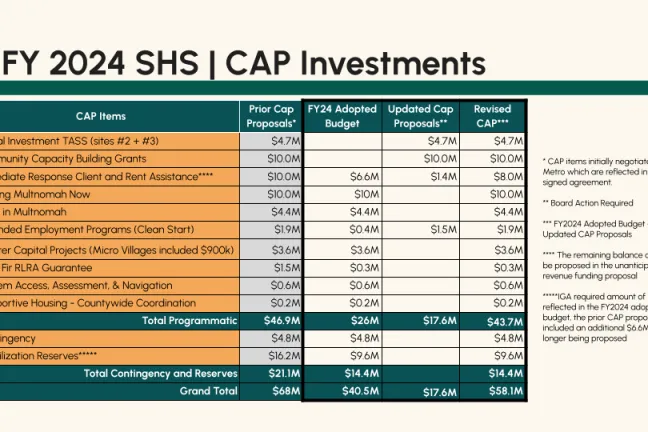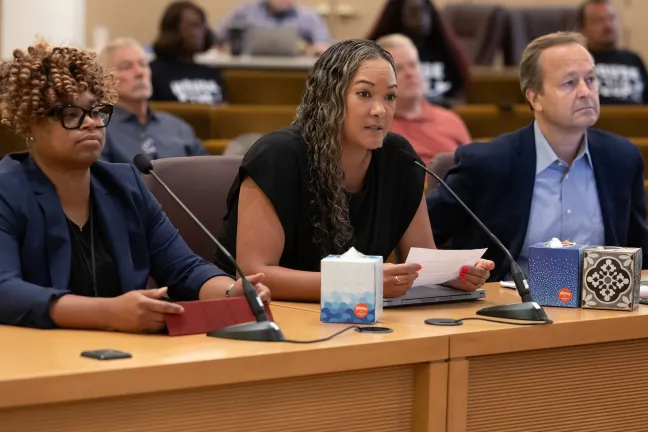The Board of Commissioners on Aug. 24 received a briefing from the Joint Office of Homeless Services on a series of proposed investments included in a corrective action plan designed to address Supportive Housing Services underspending in Fiscal Year 2023.
Metro and Multnomah County Chief Operating Officer Serena Cruz reached an agreement on the corrective action plan earlier in August. The $58 million plan — including contingency and reserve funds — identifies spending priorities such as capital support for the City of Portland’s next two Temporary Alternative Shelter Sites, support for providers to deal with workforce challenges and rent assistance.
(Separate from the underspending addressed in the Aug. 24 briefing, the Board has also been deliberating on how to allocate unanticipated Supportive Housing Services revenue that all three counties are expected to receive from Metro.)
The estimated total of underspent Supportive Housing Services dollars has been revised over the past several months, since the accounting for the last quarter of FY 2023 was not finalized until recently.
The Joint Office also highlighted some of the progress under way as a result of the Supportive Housing Services measure.
“I don't want us to lose sight that 1,318 people who might have otherwise been in a shelter or on our streets now have homes thanks to the work of SHS this year,” said Kanoelehua Egleston, director of programs at the Joint Office. “This work is making a difference.”
Egleston highlighted several other datapoints from the recently released fiscal year 2023 quarterly report that showed the Joint Office made significant gains in the previous fiscal year.
Questions about underspend and process
Commissioner Lori Stegmann asked what type of rental assistance was included in the corrective action plan — would it be used more to prevent evictions or to rehouse people currently experiencing homelessness?
“It will be for immediate client assistance,” Egleston said, “so really focused on providing Joint Office providers with barrier reduction, application readiness and housing placement and housing retention capacity. Focused more on the placement versus eviction prevention.”.
Stegmann also asked about the contingency and reserves funds included in the corrective action plan, calling back to previous Board questions about whether those funds could be reduced.
“Do we still have any flexibility to reduce the amount that we have in contingency or stabilization reserves?” Stegmann said.
Antoinette Payne said that the contingency and reserves in the corrective action plan aligns with the County’s Board-approved intergovernmental agreement with Metro. “What we currently have in our CAP is just what is required by the IGA,” Payne said. “So, the minimal amount.”
Stegmann said she supported the investments in the plan.
“We have been talking about having a better partnership with the City of Portland, and we are doing it. We have been talking about how significantly underpaid our frontline workers are. We are going to contribute $10 million. We are doing that,” Stegmann said. “I just want you to know I support what is being presented. We have to get this money out the door, and it will help people immediately.”
Commissioner Sharon Meieran expressed frustration with the way the corrective action plan was finalized, saying the plan negotiated with Metro didn’t go far enough and didn’t include input from the Board as it was being developed.
Meieran also said she questioned many of the investments included in the plan, including the proposed $10 million for capacity-building grants for service providers.
“Here we are proposing to give another $10 million to organizations without any accountability, transparency or ability to follow the money. Capacity building without measurable goals, metrics and accountability, and a clear tie to a bigger plan, is just giving away money,” Meieran said.
Instead, Meieran proposed the Joint Office allocate about $1 million to conduct a “performance and best practices” audit of provider organizations.
“Based on those recommendations,” she said, “we can target funds and truly build meaningful capacity that will allow us to optimize all of our investments moving forward.”
Meieran also raised questions about the proposed investments in rent assistance, funding for the City’s Temporary Alternative Shelter Sites, funding for Central City Concern’s Clean Start employment and community cleanup program, and more. She requested more time to deliberate before voting on the investments.
“I continue to hear the urgency around spending the funds rather than the results we want to see,” Meieran said, indicating that she would likely vote “no” on the proposed investments without further conversation.
Commissioner Susheela Jayapal asked whether the plan includes the right balance between longer-term rental assistance and shorter-term rental assistance (the corrective action plan includes $1.4 million in immediate rent assistance).
“That was the game-changer of the Supporting Housing Services Measure: the ability to provide long-term rent assistance, which we hadn't been able to do before because we didn't have a long-term funding stream,” she said.
She also responded to Meieran’s comment that the corrective action plan is too focused on spending, rather than outcomes. “It is unfortunate it has become a race to spend dollars,” she said. But, she said, “the climate is focusing on spending. The heat and the emphasis and the, frankly, blaming and shaming happening in the public arena has led us to the place we are today. It is not ideal, but it is what we are dealing with.”
Jayapal said she supports the $10 million for provider capacity-building, referencing both the recent County Auditor’s Office report on the Joint Office and a provider wage study published by the Joint Office.
“We cannot expect our partners to perform to metrics if we are not giving them what they need in order to perform. The audit and the wage study make that crystal clear,” she said. “I think these capacity building grants will help us get there.”
Jayapal said that while both the audit and the wage study also revealed process issues at the Joint Office, they both pointed to a need for more funding for providers.
“That is a good use of this underspent funding given it is one of the reasons we have underspending in the first place,” she said.
Commissioner Brim-Edwards said she was frustrated that the briefing was the last item on the agenda for that day’s Board meeting. “We are not going to have any discussion among the commissioner members and not have a chance to adequately explore questions we have as members,” Brim-Edwards said.
And, she said she wanted to consider the plan as part of a big-picture strategy. “These investments need to be part of a larger strategic framework versus a spend-down framework that gets us in compliance with a corrective action plan unilaterally handed to us.”
Brim-Edwards said she had questions about the capacity-building grants included in the corrective action plan.
“It is my understanding that the $10 million that would go out to the organizations — we are later going to find out who they are and how much they receive — is not actually to provide additional services. I just want to make sure I have this clear, they can spend it to their discretion and there are no additional requirements or services they provide?”
Field said the funds are meant to help providers overcome current workforce and capacity challenges that contributed to underspending last year as additional Supportive Housing Services dollars began flowing.
“It is designed to fund workforce support and development. It is not directly related to contracts services, but will be provided to our contracted providers to support their workforce growth and development,” Field said. “We think the providers are best-suited to decide how they need to grow and support their workforce. We heard consistently for months, if not years, we are underfunding the nonprofit workforce, and this is an attempt to turn that ship around.”
Brim-Edwards also raised concerns about rent assistance, saying she had questions about specific rent assistance programs, including the regional long-term rent assistance guarantee at the Douglas Fir Apartments and the rent assistance included as part of Housing Multnomah Now.
Chair Jessica Vega Pederson closed out the briefing, explaining some of the process that went into the corrective action plan.
“As soon as I found out about the underspending for quarter 3, I immediately drafted an email to this board, the city council, the mayor and Metro, alerting them to the underspending and the plans to rectify that. The amount of underspending that was apparent was appalling,” she said. “The work that you see in front of you today is a result of the fact that Metro recognized that that underspending amount was appalling and they wanted to engage more fully. There have been weeks of negotiation between Metro and the County to bring us to this point today.”
Vega Pederson expressed gratitude that the Joint Office in quarter four of the last fiscal year worked on its own to significantly increase dollars going out to providers, reducing the amount of underspend, but more importantly allowing more resources to serve people in the community.
“I want to thank and appreciate the Joint Office for the really hard work in the last quarter of fiscal year 2023 to make sure that we were fulfilling the budget allotments for that year,” she said. “The reason we have a smaller amount for the [corrective action plan] right now is because there is a greater increase in actually fulfilling those items and getting that money to our providers to do the work. That is a very significant thing.”
Vega Pederson also discussed the priorities included in the corrective action plan.
“I want to remind this Board, this underspending amount and unanticipated revenue are one-time only dollars. That is limiting in terms of what we can do with this money.” Vega Pederson said. Given those limitations, she said, the corrective action plan emphasizes provider capacity-building, partnership with the City of Portland, investing in emergency rental assistance, and workforce development.
Vega Pederson also said the plan’s proposed $1.5 million investment in Central City Concern’s Clean Start program was a deliberate choice to leverage $1 million in additional funding provided by Gov. Tina Kotek.
“Those dollars are going to different business and neighborhood districts,” Vega Pederson said, “to make sure it is not just happening in downtown, but that we are having the Clean Start program model focused on areas throughout more of the city and the county.”
Vega Pederson said the Board will have more opportunities to shape the spending on the unanticipated Supportive Housing Services dollars at upcoming Board meetings, saying she would continue prioritizing Board discussion and input, with a work session on Sept. 5 and a board vote on Sept. 7.
“This is not just a one-off. It is not just a two-off. This is an ongoing thing.”



